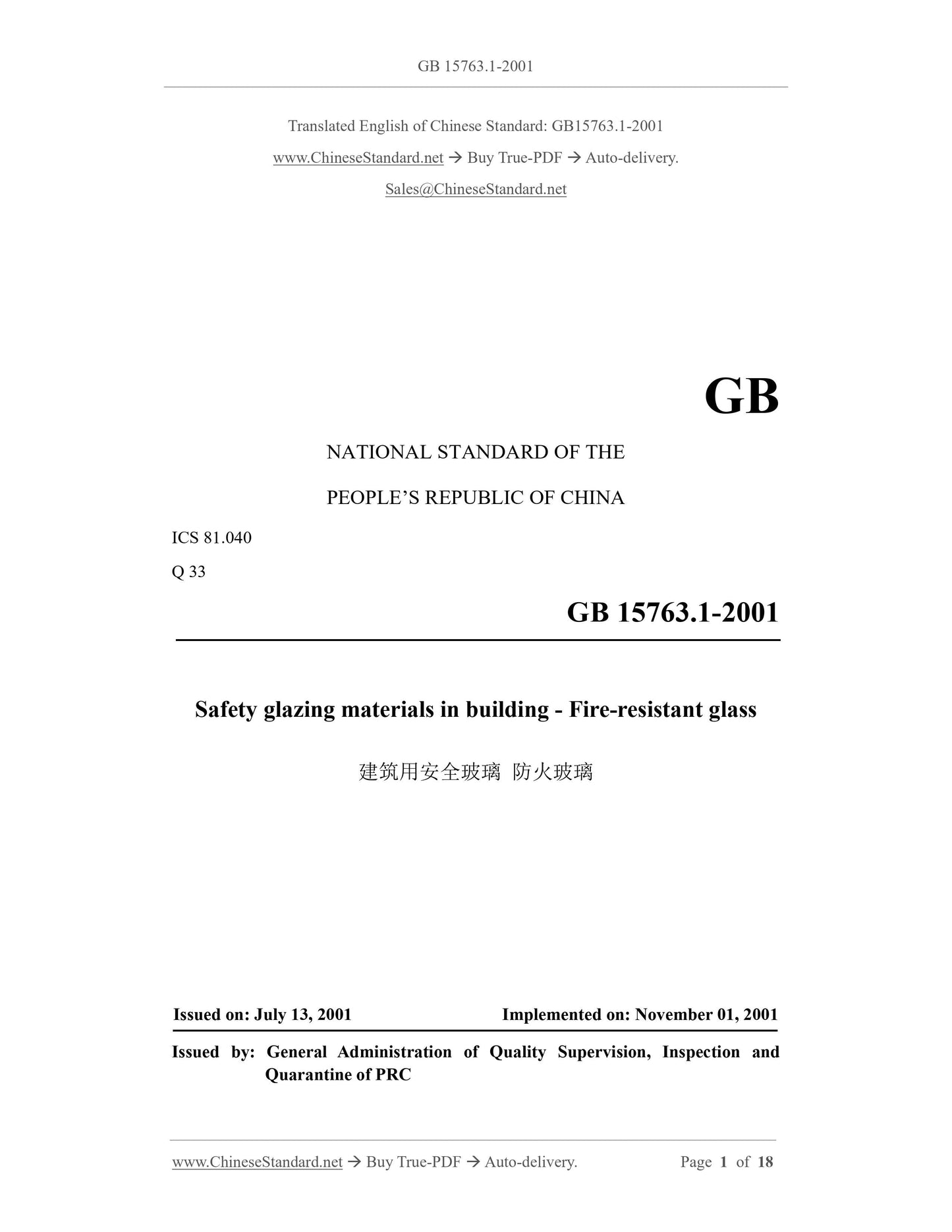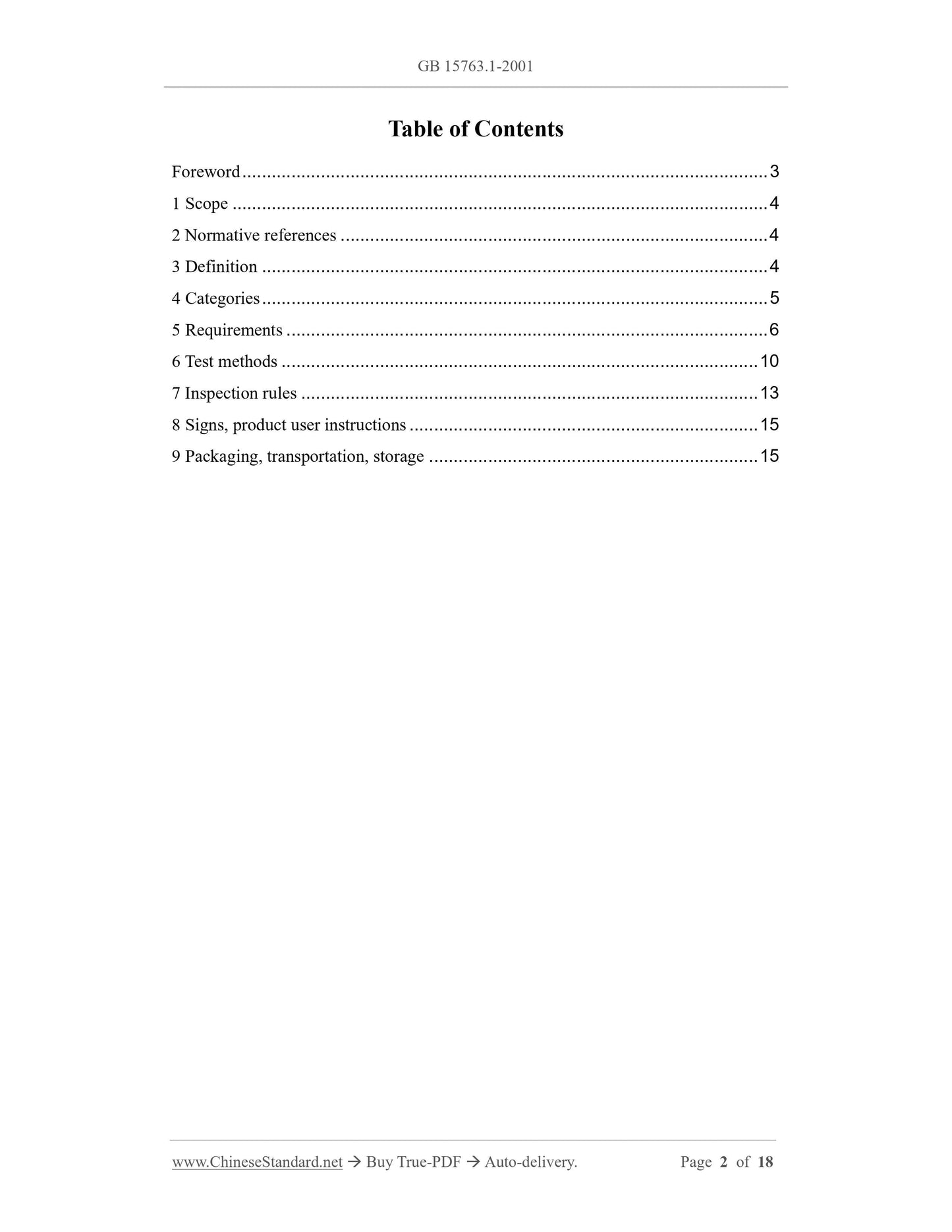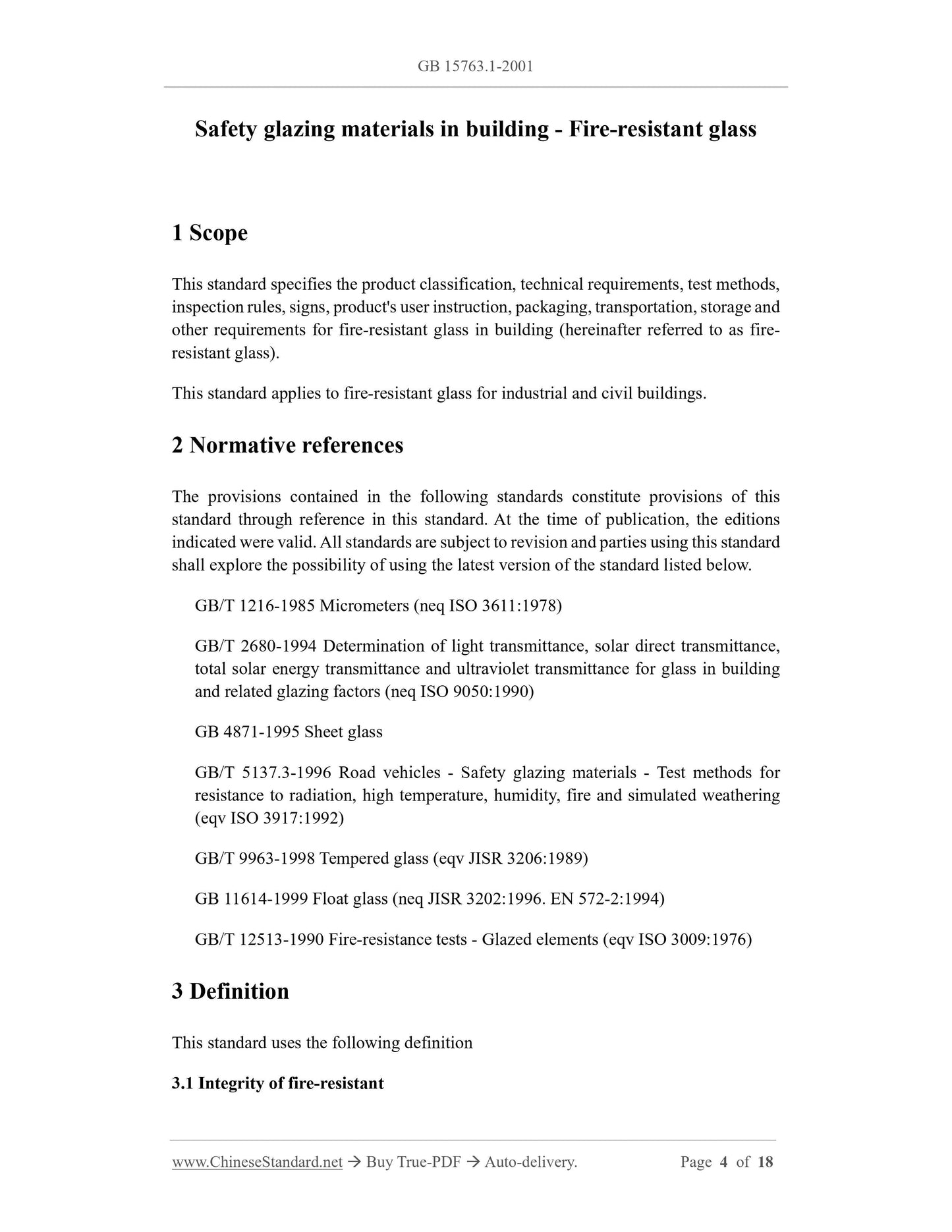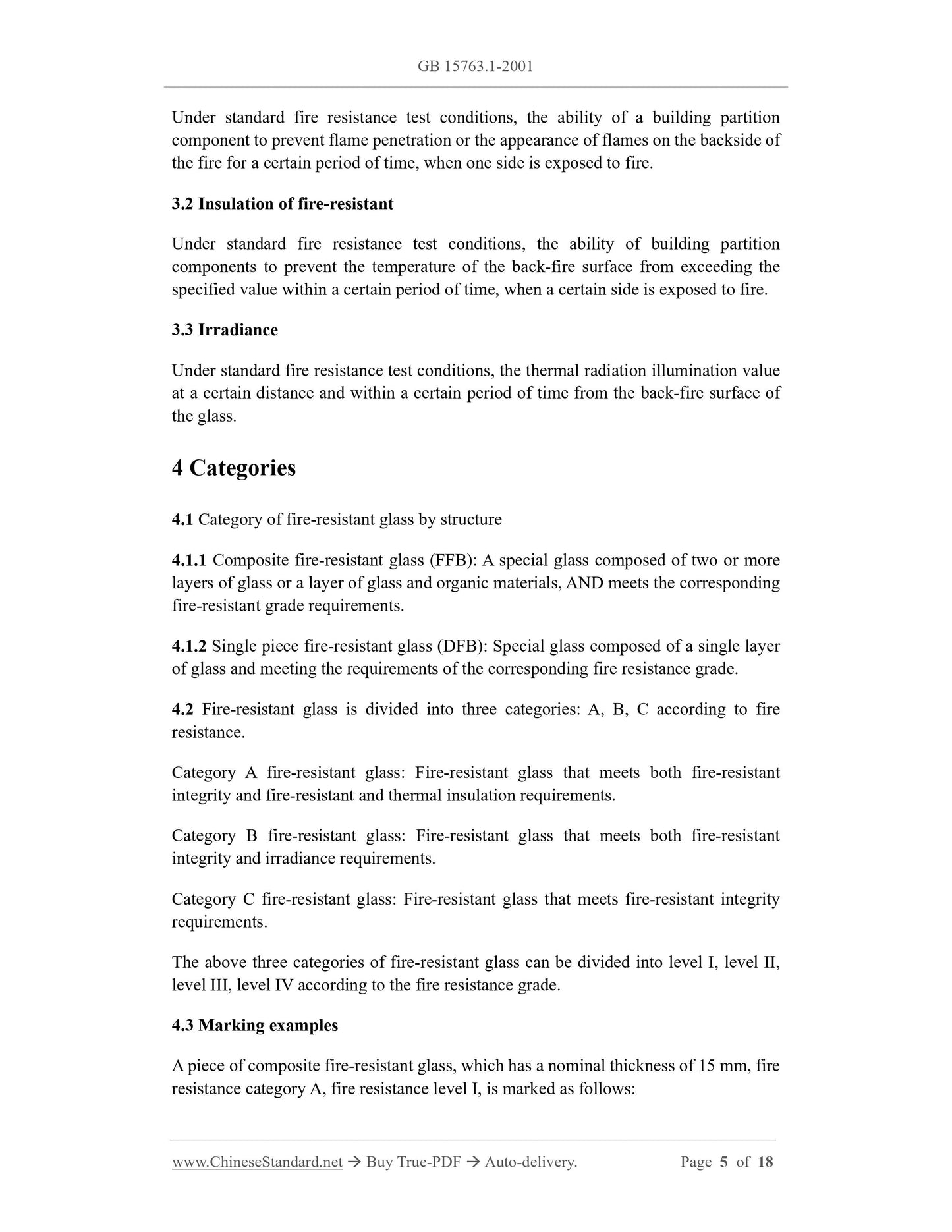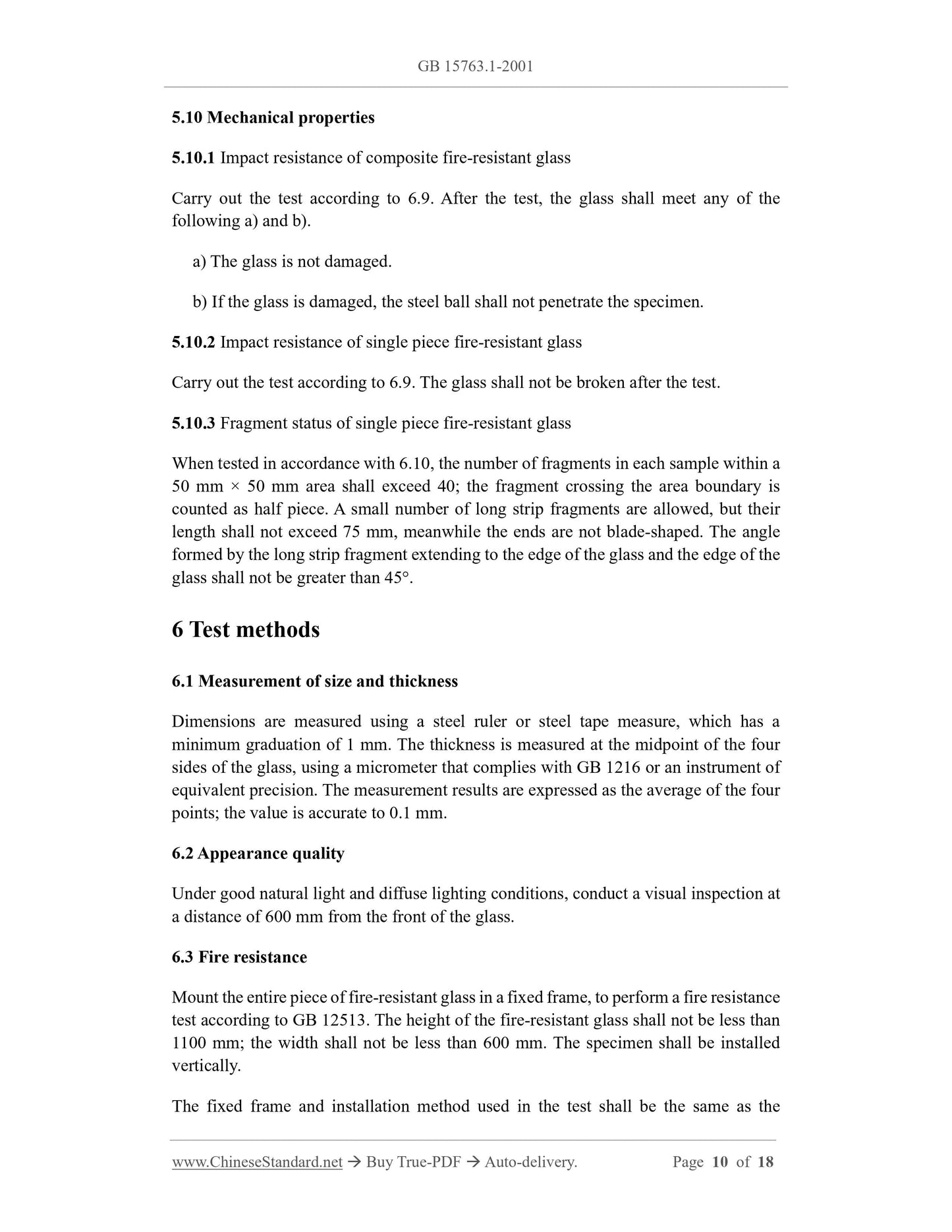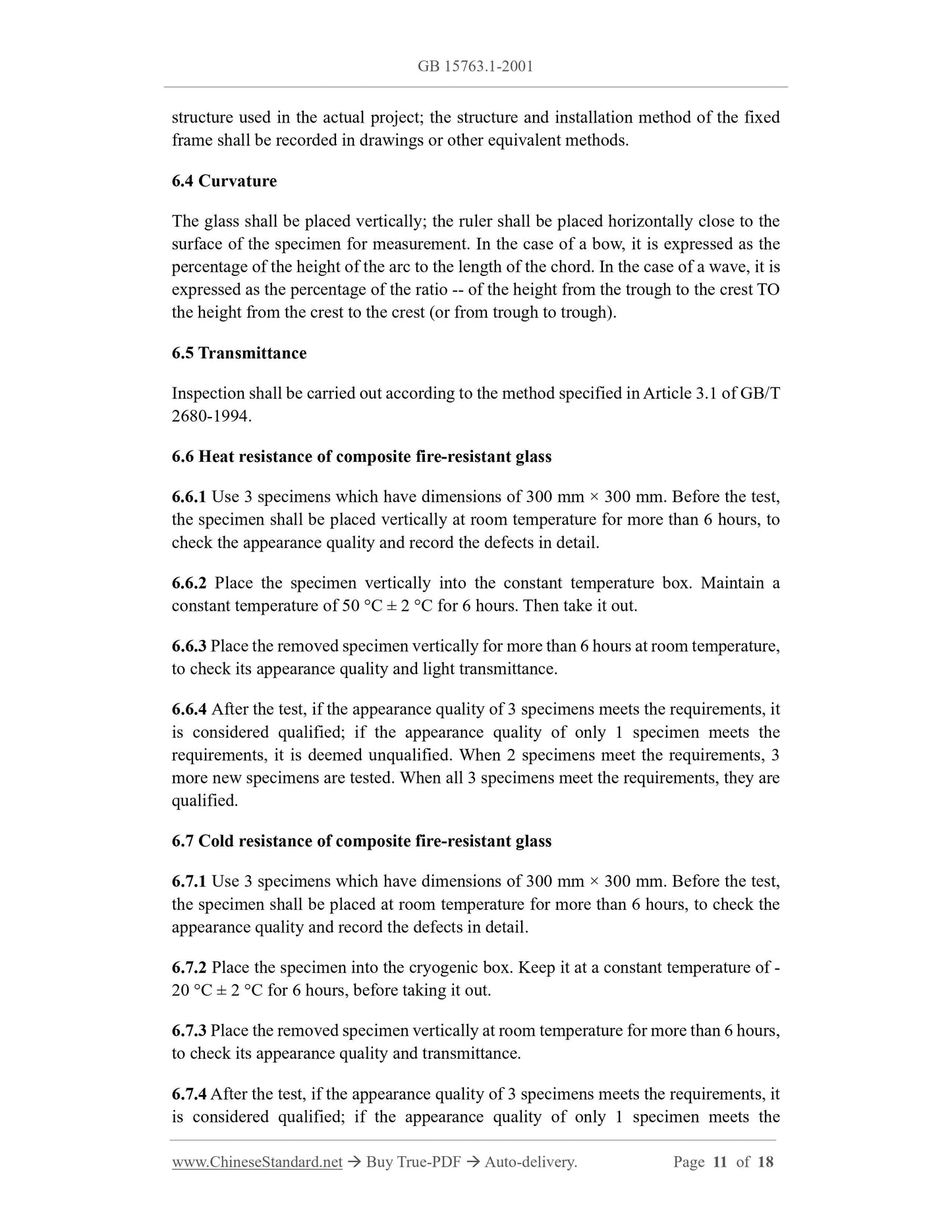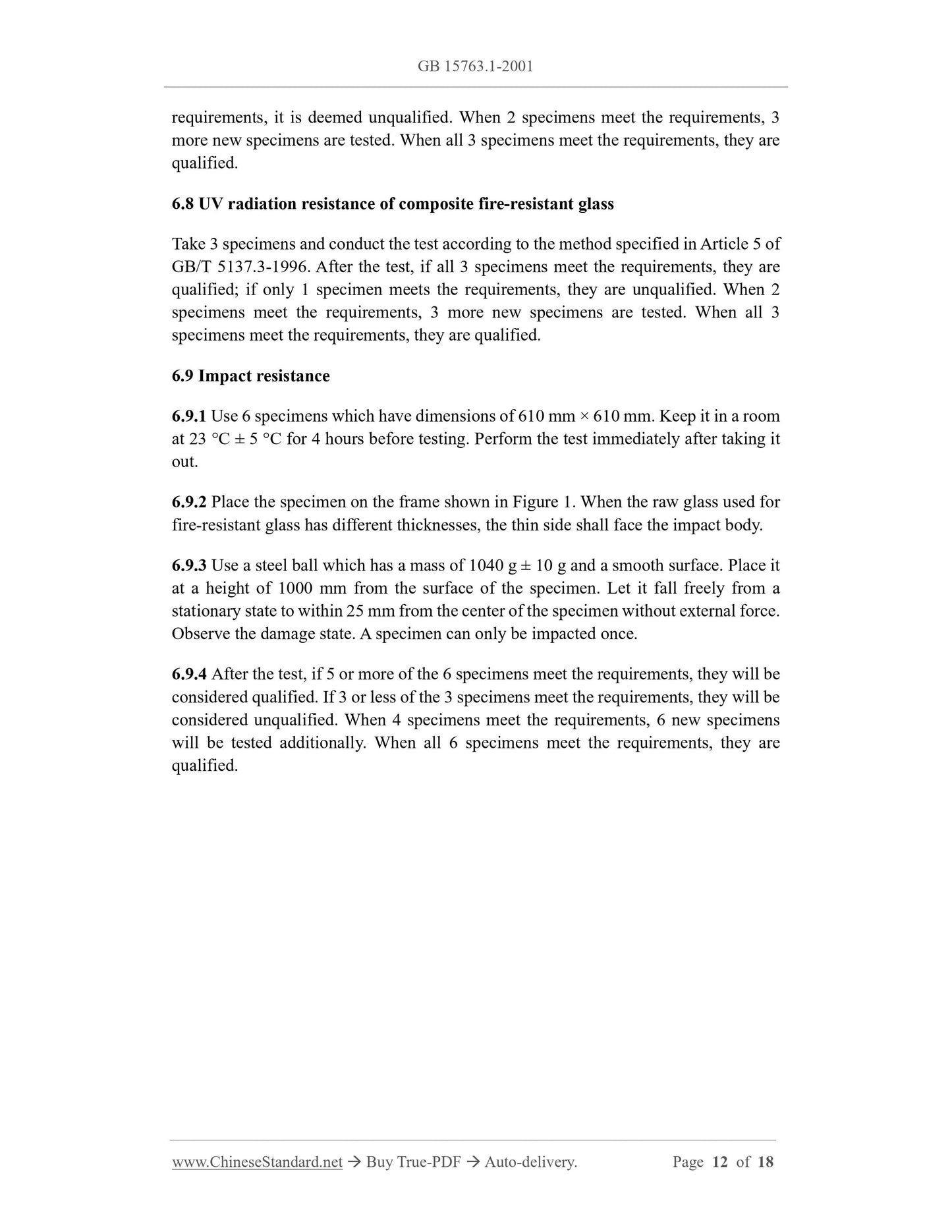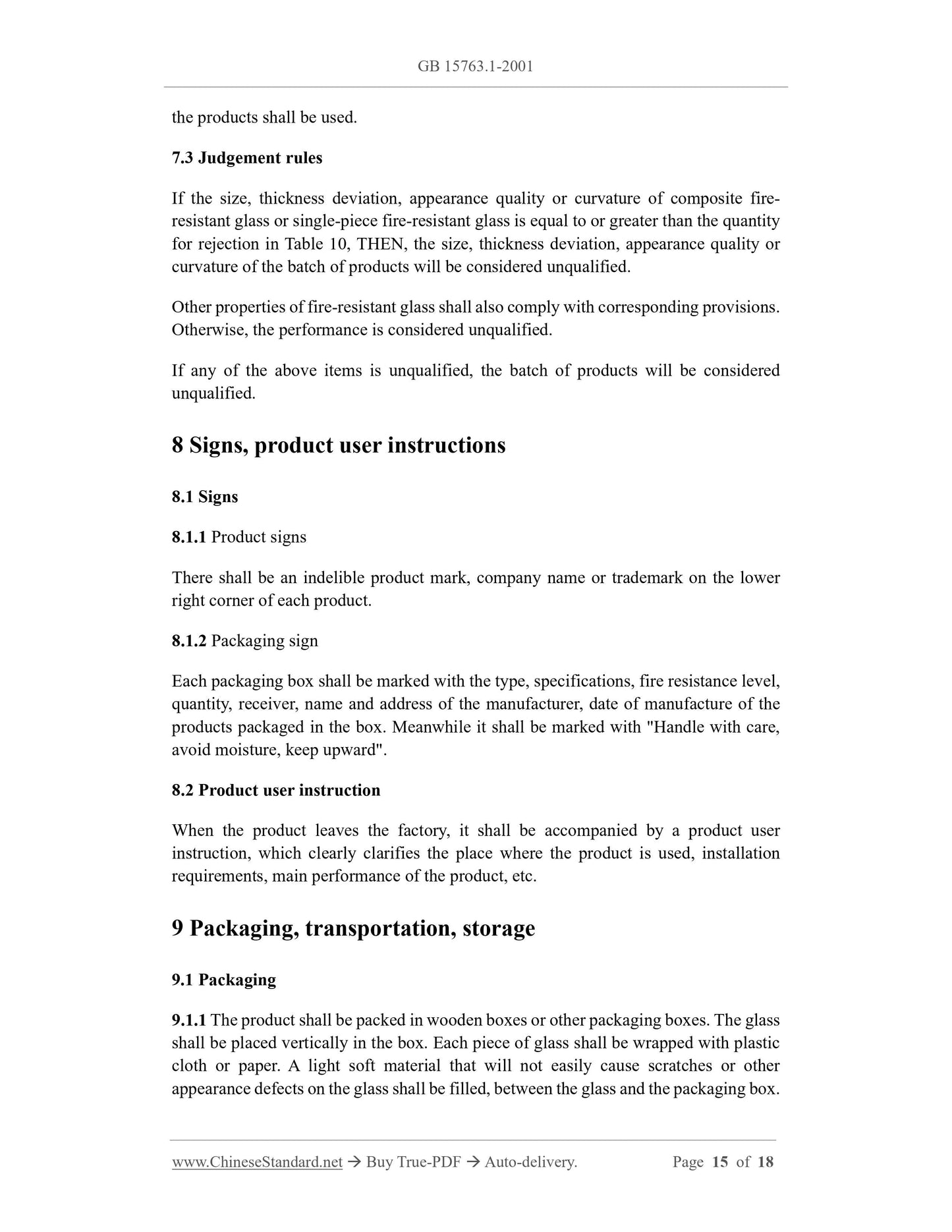1
/
dari
8
PayPal, credit cards. Download editable-PDF and invoice in 1 second!
GB 15763.1-2001 English PDF (GB15763.1-2001)
GB 15763.1-2001 English PDF (GB15763.1-2001)
Harga reguler
$390.00 USD
Harga reguler
Harga obral
$390.00 USD
Harga satuan
/
per
Biaya pengiriman dihitung saat checkout.
Tidak dapat memuat ketersediaan pengambilan
Delivery: 3 seconds. Download true-PDF + Invoice.
Get QUOTATION in 1-minute: Click GB 15763.1-2001
Historical versions: GB 15763.1-2001
Preview True-PDF (Reload/Scroll if blank)
GB 15763.1-2001: Safety glazing materials in building Fire-resistant glass
GB 15763.1-2001
GB
NATIONAL STANDARD OF THE
PEOPLE’S REPUBLIC OF CHINA
ICS 81.040
Q 33
Safety glazing materials in building - Fire-resistant glass
ISSUED ON: JULY 13, 2001
IMPLEMENTED ON: NOVEMBER 01, 2001
Issued by: General Administration of Quality Supervision, Inspection and
Quarantine of PRC
Table of Contents
Foreword ... 3
1 Scope ... 4
2 Normative references ... 4
3 Definition ... 4
4 Categories ... 5
5 Requirements ... 6
6 Test methods ... 10
7 Inspection rules ... 13
8 Signs, product user instructions ... 15
9 Packaging, transportation, storage ... 15
Safety glazing materials in building - Fire-resistant glass
1 Scope
This standard specifies the product classification, technical requirements, test methods,
inspection rules, signs, product's user instruction, packaging, transportation, storage and
other requirements for fire-resistant glass in building (hereinafter referred to as fire-
resistant glass).
This standard applies to fire-resistant glass for industrial and civil buildings.
2 Normative references
The provisions contained in the following standards constitute provisions of this
standard through reference in this standard. At the time of publication, the editions
indicated were valid. All standards are subject to revision and parties using this standard
shall explore the possibility of using the latest version of the standard listed below.
GB/T 1216-1985 Micrometers (neq ISO 3611:1978)
GB/T 2680-1994 Determination of light transmittance, solar direct transmittance,
total solar energy transmittance and ultraviolet transmittance for glass in building
and related glazing factors (neq ISO 9050:1990)
GB 4871-1995 Sheet glass
GB/T 5137.3-1996 Road vehicles - Safety glazing materials - Test methods for
resistance to radiation, high temperature, humidity, fire and simulated weathering
(eqv ISO 3917:1992)
GB/T 9963-1998 Tempered glass (eqv JISR 3206:1989)
GB 11614-1999 Float glass (neq JISR 3202:1996. EN 572-2:1994)
GB/T 12513-1990 Fire-resistance tests - Glazed elements (eqv ISO 3009:1976)
3 Definition
This standard uses the following definition
3.1 Integrity of fire-resistant
Under standard fire resistance test conditions, the ability of a building partition
component to prevent flame penetration or the appearance of flames on the backside of
the fire for a certain period of time, when one side is exposed to fire.
3.2 Insulation of fire-resistant
Under standard fire resistance test conditions, the ability of building partition
components to prevent the temperature of the back-fire surface from exceeding the
specified value within a certain period of time, when a certain side is exposed to fire.
3.3 Irradiance
Under standard fire resistance test conditions, the thermal radiation illumination value
at a certain distance and within a certain period of time from the back-fire surface of
the glass.
4 Categories
4.1 Category of fire-resistant glass by structure
4.1.1 Composite fire-resistant glass (FFB): A special glass composed of two or more
layers of glass or a layer of glass and organic materials, AND meets the corresponding
fire-resistant grade requirements.
4.1.2 Single piece fire-resistant glass (DFB): Special glass composed of a single layer
of glass and meeting the requirements of the corresponding fire resistance grade.
4.2 Fire-resistant glass is divided into three categories: A, B, C according to fire
resistance.
Category A fire-resistant glass: Fire-resistant glass that meets both fire-resistant
integrity and fire-resistant and thermal insulation requirements.
Category B fire-resistant glass: Fire-resistant glass that meets both fire-resistant
integrity and irradiance requirements.
Category C fire-resistant glass: Fire-resistant glass that meets fire-resistant integrity
requirements.
The above three categories of fire-resistant glass can be divided into level I, level II,
level III, level IV according to the fire resistance grade.
4.3 Marking examples
A piece of composite fire-resistant glass, which has a nominal thickness of 15 mm, fire
resistance category A, fire resistance level I, is marked as follows:
5.10 Mechanical properties
5.10.1 Impact resistance of composite fire-resistant glass
Carry out the test according to 6.9. After the test, the glass shall meet any of the
following a) and b).
a) The glass is not damaged.
b) If the glass is damaged, the steel ball shall not penetrate the specimen.
5.10.2 Impact resistance of single piece fire-resistant glass
Carry out the test according to 6.9. The glass shall not be broken after the test.
5.10.3 Fragment status of single piece fire-resistant glass
When tested in accordance with 6.10, the number of fragments in each sample within a
50 mm × 50 mm area shall exceed 40; the fragment crossing the area boundary is
counted as half piece. A small number of long strip fragments are allowed, but their
length shall not exceed 75 mm, meanwhile the ends are not blade-shaped. The angle
formed by the long strip fragment extending to the edge of the glass and the edge of the
glass shall not be greater than 45°.
6 Test methods
6.1 Measurement of size and thickness
Dimensions are measured using a steel ruler or steel tape measure, which has a
minimum graduation of 1 mm. The thickness is measured at the midpoint of the four
sides of the glass, using a micrometer that complies with GB 1216 or an instrument of
equivalent precision. The measurement results are expressed as the average of the four
points; the value is accurate to 0.1 mm.
6.2 Appearance quality
Under good natural light and diffuse lighting conditions, conduct a visual inspection at
a distance of 600 mm from the front of the glass.
6.3 Fire resistance
Mount the entire piece of fire-resistant glass in a fixed frame, to perform a fire resistance
test according to GB 12513. The height of the fire-resistant glass shall not be less than
1100 mm; the width shall not be less than 600 mm. The specimen shall be installed
vertically.
The fixed frame and installation method used in the test shall be the same as the
structure used in the actual project; the structure and installation method of the fixed
frame shall be recorded in drawings or other equivalent methods.
6.4 Curvature
The glass shall be placed vertically; the ruler shall be placed horizontally close to the
surface of the specimen for measurement. In the case of a bow, it is expressed as the
percentage of the height of the arc to the length of the chord. In the case of a wave, it is
expressed as the percentage of the ratio -- of the height from the trough to the crest TO
the height from the crest to the crest (or from trough to trough).
6.5 Transmittance
Inspection shall be carried out according to the method specified in Article 3.1 of GB/T
2680-1994.
6.6 Heat resistance of composite fire-resistant glass
6.6.1 Use 3 specimens which have dimensions of 300 mm × 300 mm. Before the test,
the specimen shall be placed vertically at room temperature for more than 6 hours, to
check the appearance quality and record the defects in detail.
6.6.2 Place the specimen vertically into the constant temperature box. Maintain a
constant temperature of 50 °C ± 2 °C for 6 hours. Then take it out.
6.6.3 Place the removed specimen vertically for more than 6 hours at room temperature,
to check its appearance quality and light transmittance.
6.6.4 After the test, if the appearanc...
Get QUOTATION in 1-minute: Click GB 15763.1-2001
Historical versions: GB 15763.1-2001
Preview True-PDF (Reload/Scroll if blank)
GB 15763.1-2001: Safety glazing materials in building Fire-resistant glass
GB 15763.1-2001
GB
NATIONAL STANDARD OF THE
PEOPLE’S REPUBLIC OF CHINA
ICS 81.040
Q 33
Safety glazing materials in building - Fire-resistant glass
ISSUED ON: JULY 13, 2001
IMPLEMENTED ON: NOVEMBER 01, 2001
Issued by: General Administration of Quality Supervision, Inspection and
Quarantine of PRC
Table of Contents
Foreword ... 3
1 Scope ... 4
2 Normative references ... 4
3 Definition ... 4
4 Categories ... 5
5 Requirements ... 6
6 Test methods ... 10
7 Inspection rules ... 13
8 Signs, product user instructions ... 15
9 Packaging, transportation, storage ... 15
Safety glazing materials in building - Fire-resistant glass
1 Scope
This standard specifies the product classification, technical requirements, test methods,
inspection rules, signs, product's user instruction, packaging, transportation, storage and
other requirements for fire-resistant glass in building (hereinafter referred to as fire-
resistant glass).
This standard applies to fire-resistant glass for industrial and civil buildings.
2 Normative references
The provisions contained in the following standards constitute provisions of this
standard through reference in this standard. At the time of publication, the editions
indicated were valid. All standards are subject to revision and parties using this standard
shall explore the possibility of using the latest version of the standard listed below.
GB/T 1216-1985 Micrometers (neq ISO 3611:1978)
GB/T 2680-1994 Determination of light transmittance, solar direct transmittance,
total solar energy transmittance and ultraviolet transmittance for glass in building
and related glazing factors (neq ISO 9050:1990)
GB 4871-1995 Sheet glass
GB/T 5137.3-1996 Road vehicles - Safety glazing materials - Test methods for
resistance to radiation, high temperature, humidity, fire and simulated weathering
(eqv ISO 3917:1992)
GB/T 9963-1998 Tempered glass (eqv JISR 3206:1989)
GB 11614-1999 Float glass (neq JISR 3202:1996. EN 572-2:1994)
GB/T 12513-1990 Fire-resistance tests - Glazed elements (eqv ISO 3009:1976)
3 Definition
This standard uses the following definition
3.1 Integrity of fire-resistant
Under standard fire resistance test conditions, the ability of a building partition
component to prevent flame penetration or the appearance of flames on the backside of
the fire for a certain period of time, when one side is exposed to fire.
3.2 Insulation of fire-resistant
Under standard fire resistance test conditions, the ability of building partition
components to prevent the temperature of the back-fire surface from exceeding the
specified value within a certain period of time, when a certain side is exposed to fire.
3.3 Irradiance
Under standard fire resistance test conditions, the thermal radiation illumination value
at a certain distance and within a certain period of time from the back-fire surface of
the glass.
4 Categories
4.1 Category of fire-resistant glass by structure
4.1.1 Composite fire-resistant glass (FFB): A special glass composed of two or more
layers of glass or a layer of glass and organic materials, AND meets the corresponding
fire-resistant grade requirements.
4.1.2 Single piece fire-resistant glass (DFB): Special glass composed of a single layer
of glass and meeting the requirements of the corresponding fire resistance grade.
4.2 Fire-resistant glass is divided into three categories: A, B, C according to fire
resistance.
Category A fire-resistant glass: Fire-resistant glass that meets both fire-resistant
integrity and fire-resistant and thermal insulation requirements.
Category B fire-resistant glass: Fire-resistant glass that meets both fire-resistant
integrity and irradiance requirements.
Category C fire-resistant glass: Fire-resistant glass that meets fire-resistant integrity
requirements.
The above three categories of fire-resistant glass can be divided into level I, level II,
level III, level IV according to the fire resistance grade.
4.3 Marking examples
A piece of composite fire-resistant glass, which has a nominal thickness of 15 mm, fire
resistance category A, fire resistance level I, is marked as follows:
5.10 Mechanical properties
5.10.1 Impact resistance of composite fire-resistant glass
Carry out the test according to 6.9. After the test, the glass shall meet any of the
following a) and b).
a) The glass is not damaged.
b) If the glass is damaged, the steel ball shall not penetrate the specimen.
5.10.2 Impact resistance of single piece fire-resistant glass
Carry out the test according to 6.9. The glass shall not be broken after the test.
5.10.3 Fragment status of single piece fire-resistant glass
When tested in accordance with 6.10, the number of fragments in each sample within a
50 mm × 50 mm area shall exceed 40; the fragment crossing the area boundary is
counted as half piece. A small number of long strip fragments are allowed, but their
length shall not exceed 75 mm, meanwhile the ends are not blade-shaped. The angle
formed by the long strip fragment extending to the edge of the glass and the edge of the
glass shall not be greater than 45°.
6 Test methods
6.1 Measurement of size and thickness
Dimensions are measured using a steel ruler or steel tape measure, which has a
minimum graduation of 1 mm. The thickness is measured at the midpoint of the four
sides of the glass, using a micrometer that complies with GB 1216 or an instrument of
equivalent precision. The measurement results are expressed as the average of the four
points; the value is accurate to 0.1 mm.
6.2 Appearance quality
Under good natural light and diffuse lighting conditions, conduct a visual inspection at
a distance of 600 mm from the front of the glass.
6.3 Fire resistance
Mount the entire piece of fire-resistant glass in a fixed frame, to perform a fire resistance
test according to GB 12513. The height of the fire-resistant glass shall not be less than
1100 mm; the width shall not be less than 600 mm. The specimen shall be installed
vertically.
The fixed frame and installation method used in the test shall be the same as the
structure used in the actual project; the structure and installation method of the fixed
frame shall be recorded in drawings or other equivalent methods.
6.4 Curvature
The glass shall be placed vertically; the ruler shall be placed horizontally close to the
surface of the specimen for measurement. In the case of a bow, it is expressed as the
percentage of the height of the arc to the length of the chord. In the case of a wave, it is
expressed as the percentage of the ratio -- of the height from the trough to the crest TO
the height from the crest to the crest (or from trough to trough).
6.5 Transmittance
Inspection shall be carried out according to the method specified in Article 3.1 of GB/T
2680-1994.
6.6 Heat resistance of composite fire-resistant glass
6.6.1 Use 3 specimens which have dimensions of 300 mm × 300 mm. Before the test,
the specimen shall be placed vertically at room temperature for more than 6 hours, to
check the appearance quality and record the defects in detail.
6.6.2 Place the specimen vertically into the constant temperature box. Maintain a
constant temperature of 50 °C ± 2 °C for 6 hours. Then take it out.
6.6.3 Place the removed specimen vertically for more than 6 hours at room temperature,
to check its appearance quality and light transmittance.
6.6.4 After the test, if the appearanc...
Share
